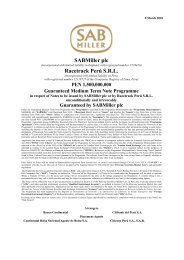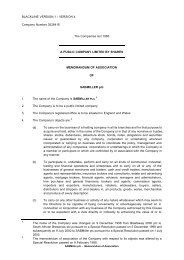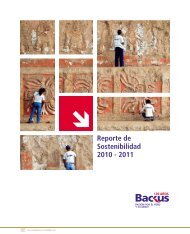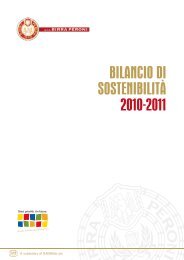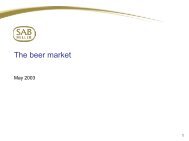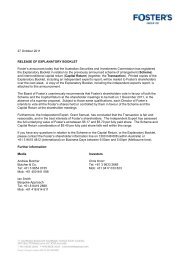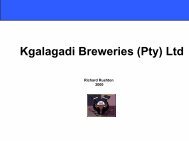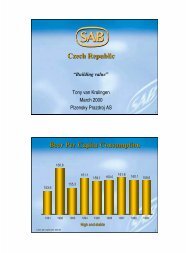Download the Tanzania Breweries Ltd 2010 Annual ... - SABMiller
Download the Tanzania Breweries Ltd 2010 Annual ... - SABMiller
Download the Tanzania Breweries Ltd 2010 Annual ... - SABMiller
You also want an ePaper? Increase the reach of your titles
YUMPU automatically turns print PDFs into web optimized ePapers that Google loves.
Notes to Financial Statements<br />
For <strong>the</strong> year ended 31 March <strong>2010</strong><br />
(All amounts in Tshs M)<br />
(l)<br />
Share capital<br />
Ordinary shares are classified as equity. Incremental costs directly<br />
attributable to <strong>the</strong> issue of new shares or options are shown in equity<br />
as a deduction, net of tax, from <strong>the</strong> proceeds.<br />
(m) Income tax<br />
Income tax expense is <strong>the</strong> aggregate of <strong>the</strong> charge to <strong>the</strong> profit and<br />
loss account in respect of current and deferred income tax. Current<br />
income tax is <strong>the</strong> amount of income tax payable on <strong>the</strong> taxable profit<br />
for <strong>the</strong> year determined in accordance with <strong>the</strong> <strong>Tanzania</strong> Income Tax<br />
Act, 2004.<br />
Deferred income tax is provided in full using <strong>the</strong> liability method<br />
on temporary differences arising between <strong>the</strong> tax bases of assets<br />
and liabilities and <strong>the</strong>ir carrying amounts in <strong>the</strong> financial statements.<br />
Deferred income tax is determined using tax rates (and laws) that<br />
have been enacted or substantially enacted at <strong>the</strong> balance sheet date<br />
and are expected to apply when <strong>the</strong> related deferred income tax<br />
asset is realized or <strong>the</strong> deferred income tax liability is settled.<br />
Deferred income tax assets are recognised to <strong>the</strong> extent that <strong>the</strong><br />
directors consider that it is probable that future taxable profit will<br />
be available against which <strong>the</strong> temporary differences can be utilized.<br />
(n)<br />
(i)<br />
Employee benefits<br />
Bonus plans<br />
The Group or Company recognises a liability and an expense for<br />
bonuses, based on a formula that takes into consideration <strong>the</strong> profit<br />
attributable to <strong>the</strong> company’s shareholders after certain adjustments.<br />
The Group or Company recognises a provision where contractually<br />
obliged or where <strong>the</strong>re is a past practice that has created a<br />
constructive obligation.<br />
(ii)<br />
Defined contribution plan<br />
The Group pays contributions to <strong>the</strong> National Social Security<br />
Fund (NSSF) and Parastatal Pensions Fund (PPF), which are publicly<br />
administered pension plans, on a mandatory basis. These are defined<br />
contribution schemes. A defined contribution plan is a pension plan<br />
under which <strong>the</strong> Group pays fixed contributions into a separate entity.<br />
The Group has no legal or constructive obligations to pay fur<strong>the</strong>r<br />
contributions if <strong>the</strong> fund does not hold sufficient assets to pay all<br />
employees <strong>the</strong> benefits relating to employee service in <strong>the</strong> current<br />
and prior periods. The Group’s contributions are recognised as an<br />
employee benefit expense when <strong>the</strong>y are due.<br />
(iii)<br />
Termination benefits<br />
Termination benefits are payable when employment is terminated<br />
before <strong>the</strong> normal retirement date, or whenever an employee<br />
accepts voluntary redundancy in exchange for <strong>the</strong>se benefits. The<br />
Group recognises termination benefits when it is demonstrably<br />
committed to terminating <strong>the</strong> employment of current employees<br />
according to a detailed formal plan without possibility of withdrawal,<br />
or providing termination benefits as a result of an offer made to<br />
encourage voluntary redundancy. Benefits falling due more than 12<br />
months after balance sheet date are discounted to present value in a<br />
similar manner to all long term employee benefits.<br />
(o)<br />
Provision<br />
Provisions are recognised when <strong>the</strong>re is a present obligation, whe<strong>the</strong>r<br />
legal or constructive, as a result of a past event for which it is probable<br />
that a transfer of economic benefits will be required to settle <strong>the</strong><br />
obligation and a reliable estimate can be made of <strong>the</strong> amount of<br />
<strong>the</strong> obligation. Such provisions are calculated on a discounted basis<br />
where <strong>the</strong> effect is material to <strong>the</strong> original undiscounted provision.<br />
The carrying amount of <strong>the</strong> provision increases in each period to<br />
reflect <strong>the</strong> passage of time and <strong>the</strong> unwinding of <strong>the</strong> discount and<br />
<strong>the</strong> movement is recognised in <strong>the</strong> income statement within interest<br />
costs.<br />
(p)<br />
(i)<br />
Revenue recognition<br />
Sale of goods<br />
Revenue represents <strong>the</strong> fair value of consideration received or<br />
receivable for goods sold to third parties and is recognised when <strong>the</strong><br />
risks and rewards of ownership are substantially transferred.<br />
The Group or Company presents revenue gross of excise duties<br />
because unlike value added tax, excise is not directly related to <strong>the</strong><br />
value of sales. It is not generally recognised as a separate item on<br />
invoices, increases in excise are not always directly passed on to<br />
customers, and <strong>the</strong> Group or Company cannot reclaim <strong>the</strong> excise<br />
where customers do not pay for product received. The Group or<br />
Company <strong>the</strong>refore considers excise as a cost to <strong>the</strong> entity and<br />
reflects it as a production cost. Consequently any excise that is<br />
recovered in <strong>the</strong> sale price is included in revenue.<br />
Revenue excludes value added tax. It is stated net of price discounts,<br />
promotional discounts and after an appropriate amount has been<br />
provided to cover <strong>the</strong> sales value of credit notes yet to be issued that<br />
relate to <strong>the</strong> current and prior periods.<br />
The same recognition criteria also apply to <strong>the</strong> sale of by-products<br />
and waste (such as spent grain, malt dust and yeast).<br />
(ii)<br />
Interest income<br />
Interest income is recognised on an accruals basis using <strong>the</strong> effective<br />
interest method.<br />
(iii)<br />
Royalty income<br />
Royalty income is recognised on an accruals basis in accordance with<br />
<strong>the</strong> relevant agreements and is included in o<strong>the</strong>r income.<br />
(iv)<br />
Dividend income<br />
Dividend income is recognised when <strong>the</strong> right to receive payment is<br />
established.<br />
Page 30<br />
<strong>Tanzania</strong> <strong>Breweries</strong> Limited



